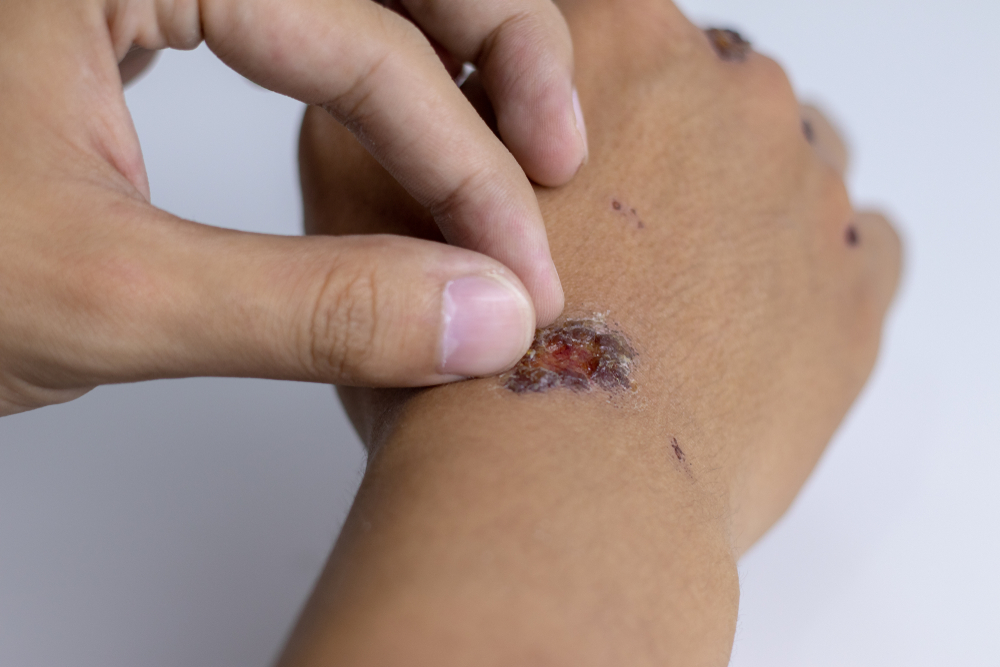


Many people who abuse drugs try so much to hide their secrets. And most of them manage to do so, especially in the early stages. But the thing about drug use is at some point, the signs start to show – either through psychological, behavioral, or physical signs. In this article, we’ll discuss how to recognize the warning signs of drug abuse through skin wounds, scabs, and lesions.
Drug use and addiction don’t just cause negative mental health and physical issues. It can also lead to a range of skin and soft-tissue issues. Here are some common drugs that cause skin problems:
Meth is one of the most well-known drugs for causing issues like skin wounds. It’s highly addictive and affects the central nervous system. People who use meth often experience intense itching, which leads to skin picking and scratching. Methamphetamine abuse can also lead to "meth mites," a sensation where users feel like bugs are crawling under their skin, further driving them to scratch and harm their skin.

Heroin is typically injected, which is why people who use it often develop track marks—bruised, damaged areas along the veins. Repeated injections can lead to scarring, abscesses, and infections, especially if non-sterile needles are used.
Heroin users also practice skin popping, where they directly inject the drug under the skin instead of the vein. And with obsessive picking, users are likely to get necrotizing skin lesions and infections. And let’s not forget that heroin suppresses the immune system, making it easier for skin wounds to get infected and harder for the body to heal.
Cocaine, particularly when snorted or smoked, can cause skin damage around the nose and mouth. However, when injected, it also causes track marks and abscesses, much like heroin. Cocaine use can make you feel restless and lead to obsessive skin picking. Over time, this can cause open wounds, lesions, and serious infections. The stimulant effects of cocaine also cause blood vessels to constrict, leading to high blood pressure, poor circulation, and a higher risk of skin damage.
Fentanyl and other synthetic opioids can lead to similar skin problems as heroin, including track marks, abscesses, and infections from repeated injections. They also affect the immune system, making it harder for your body to fight infections. Opioids also cause dehydration, leaving the skin dry and prone to cracking, which creates even more opportunities for bacteria and fungi to enter and cause bacterial and fungal infections.
While alcohol might not directly cause skin wounds like meth or heroin, it can lead to severe skin issues. Alcohol dehydrates your body, making your skin dry and flaky. Over time, heavy drinking can lead to a yellowish, jaundiced appearance due to liver damage. Alcohol also weakens your immune system, making you more susceptible to infections and other skin problems.

If you’re concerned that a loved one is abusing drugs or alcohol, looking out for physical signs is a good starting point. Sores, skin wounds, or infections can be early indicators, but there are other changes to watch for:
If someone’s skin starts to look different—either more irritated, pale, or unhealthy—that can be an early sign of drug use. Watch for sudden outbreaks of acne, random scabs, or red, irritated skin. Drugs like methamphetamine can cause severe acne or sores from skin picking, which often appear out of nowhere. If you notice these changes and they don’t seem to heal, that’s a sign something might be wrong.
Track marks are one of the more apparent signs of drug use, especially with substances like heroin or Fentanyl. These marks usually appear as minor, dark bruises or scars along veins, especially on the arms, legs, or hands. Repeated injections damage the veins and leave behind noticeable scars. If you notice bruising or marks that don’t seem to have an explanation, it could be a sign of intravenous drug use.
Skin infections, like abscesses (painful, swollen lumps filled with pus), can be a clear indicator of drug use, especially with those who inject drugs. These infections happen because non-sterile needles allow bacteria to enter the skin, leading to infections like staphylococcus aureus or necrotizing fasciitis. If someone has recurring or unexplained skin infections, that’s a major red flag.
Some drugs, like meth or cocaine, cause a sensation that feels like bugs crawling under the skin, leading to obsessive scratching or picking. If someone is constantly scratching, picking at their skin, or creating sores that won’t heal, this is a sign they may be using drugs. These skin wounds can get infected and turn into scars if left untreated.

If someone’s skin starts to look paler than usual, or if you notice a yellowish (jaundiced) tint, it could indicate liver problems from alcohol or opioid abuse. A jaundiced appearance is often linked to liver damage, which happens when your body can’t correctly filter toxins. A pale complexion can also suggest poor circulation due to drug use, especially with substances that affect blood flow, like heroin.
Drugs like methamphetamine can make someone look older than they are. You might notice deeper wrinkles, sagging skin, or a tired appearance. This happens because drugs dehydrate the body and break down collagen, which keeps skin firm and youthful-looking. If someone seems to age rapidly, especially in their skin, drug use could be the cause.
Some drugs make the skin more sensitive to sunlight, causing sunburns or dark spots more easily. If you notice that someone’s skin seems to be burning faster or developing dark patches, especially when they’re outside, this could be a side effect of drug use.
Discoloration in the skin, especially around the hands, feet, or injection sites, can be an early sign of drug-related vascular problems. Poor circulation caused by drug use can turn skin a bluish or purplish color, especially in the extremities. This is a sign that the veins or arteries are damaged and the skin lacks oxygen.
If you’re worried about your loved one’s skin issues due to drug use, the good news is that many of the effects can be reversed with the right care. Once they stop using, their body can begin to heal. Minor wounds, sores, and infections often improve with proper hygiene and medical treatment. However, more serious conditions, like deep scars or severe infections, may need more intensive care. The sooner your loved one seeks help, the better their chances of healing their skin and overall health.

If your loved one is showing signs of drug use, it’s essential to act quickly. These could be early signs of a larger issue that may worsen if left untreated.
Here’s when you should think about getting help:
Seeking help doesn’t just mean addressing the physical effects of drug use. Finding treatment for their substance use disorder is critical to a full recovery. You can also look into harm reduction strategies to lower their risks until they’re ready for treatment. Encouraging them to seek help is one of the best things you can do for their health and your peace of mind.
It’s never too late to take that first step and ask for help. Give us a call today, we are available 24/7, 365 days a year:


